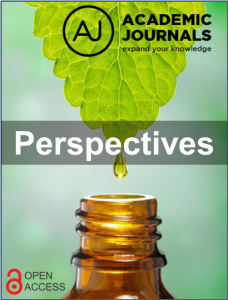Malone University, Canton, Ohio, USA
DOI: https://doi.org/10.5897/PP2018/0004
Copyright © 2018 Author(s) retain the copyright of this article.
This article is published under the terms of the Creative Commons Attribution License 4.0.
Green tea is one of the most popular drinks in the world, second only to water. It acts as an anti-oxidant and is beneficial in the treatment of cancer, obesity, viral infections (including HIV), and Alzheimer’s disease. Unlike drugs or many plant-derived medicinal compounds, green tea is readily available, inexpensive, and has a pleasant taste. These qualities make it an excellent addition to therapies for many diseases, either alone or combined with some other drugs. Polyphenols are powerful anti-oxidants found in green tea. Epigallocatechin gallate (EGCG) is the most abundant, active, and best studied green tea polyphenols and is often used in its purified form to treat illnesses. Epicatechin (EC) is found in lower concentrations in green tea and appears to have less medicinal value alone. This study briefly shows that EGCG combined with EC works much better than either polyphenol alone in stimulating normal human T lymphocyte functions and reducing growth of cancerous T lymphocytes.
Normal T lymphocytes, especially Th1 cells, are the cornerstone of the immune response, especially in defense against viruses. They are stimulated to divide and increase their activities by the Th1 cytokine (immune messenger molecule) tumor necrosis factor-beta (TNF-beta) and their division and activity are decreased by the T regulatory cytokine interleukin-10 (IL-10). High levels of TNF-beta and low levels of IL-10 thus stimulate normal T lymphocytes to grow and protect the body from multiple diseases. Growth of cancerous T lymphocytes is similar, so that effective treatment for this leukemia would lower levels of TNF-beta, increase levels of IL-10, and block leukemic cell growth.
Table 1 shows that growth of leukemic T lymphocytes is decreased by EC as its concentration is increased from 0 μM EC (78,339) to 100 μM EC (52,888). EGCG alone also reduces leukemia growth as its concentration is raised from 0 μM EGCG (78,339) to 20 μM EGCG (4679). Using both 100 μM EC and 20 μM EGCG lowers leukemic cell growth even more (2848) for a decrease in growth of 96%. Normal T lymphocyte growth (Table 2) in the absence of EC and EGCG is 22,045 and also decreases in the presence of 100 μM EC and 20 μM EGCG down to 14,624, a decrease of only 34%. Combining EC and EGCG, therefore, decreases growth of protective, normal T lymphocytes much less than that of leukemia cells.
Table 1. Growth of Leukemic Lymphocytes
| EGCG 0 | EGCG 10 | EGCG 20 | |
| EC 0 | 78339 | 34586 | 4679 |
| EC 50 | 52399 | 26654 | 4648 |
| EC100 | 52888 | 19810 | 2848 |
Table 2. Growth of Normal Lymphocytes
| EGCG 0 | EGCG 10 | EGCG 20 | |
| EC 0 | 22045 | 20168 | 20437 |
| EC 50 | 15531 | 16624 | 16666 |
| EC100 | 16753 | 17328 | 14264 |
Production of Th1 cytokine and growth factor TNF-beta by leukemia cells (Table 3) is not affected by a combination of 100 μM EC and 20 μM EGCG (46 pM TNF in the absence of EC and EGCG compared to 44 pM in the presence of both polyphenols). Production of TNF-beta by normal T lymphocytes (Table 4), however, increases from 344 pM TNF in the absence of EC and EGCG up to 2779 pM TNF, an 8-fold increase. These data show that combining EC and EGCG increases production of the protective growth factor TNF-beta by normal, but not leukemic, lymphocytes.
Production of the T regulatory and anti-growth cytokine IL-10 by leukemia cells (Table 5) is greatly increased by a combination of 100 μM EC and 20 μM EGCG (210 pM IL-10 in the absence of EC and EGCG compared to 1971 pM in the presence of both polyphenols; 9-fold increase). Production of IL-10 by normal T lymphocytes (Table 6), however, is much less affected by EC and
Table 3. TNF-beta Production by Leukemic Lymphocytes
| EGCG 0 | EGCG 10 | EGCG 20 | |
| EC 0 | 46 | 41 | 33 |
| EC 50 | 46 | 46 | 43 |
| EC100 | 51 | 46 | 44 |
Table 4. TNF-beta Production by Normal Lymphocytes
| EGCG 0 | EGCG 10 | EGCG 20 | |
| EC 0 | 344 | 385 | 736 |
| EC 50 | 504 | 756 | 1677 |
| EC100 | 937 | 2186 | 2770 |
Table 5. IL-10 Production by Leukemic Lymphocytes
| EGCG 0 | EGCG 10 | EGCG 20 | |
| EC 0 | 210 | 341 | 729 |
| EC 50 | 569 | 811 | 975 |
| EC100 | 610 | 1035 | 1971 |
Table 6. IL-10 Production by Normal Lymphocytes
| EGCG 0 | EGCG 10 | EGCG 20 | |
| EC 0 | 651 | 613 | 710 |
| EC 50 | 739 | 608 | 755 |
| EC100 | 838 | 750 | 902 |
EGCG (651 pM IL-10 in the absence of EC and EGCG compared to 902 pM IL-10, an increase of only 28%. These data show that combining EC and EGCG increases production of the anti-growth cytokine IL-10 much more powerfully by leukemic lymphocytes than normal ones.
This study shows that a combination of green tea polyphenols, EC and EGCG is much more effective than either polyphenol alone in stopping growth of leukemic T cells and production of associated cytokines and encouraging growth of protective normal T lymphocytes.






